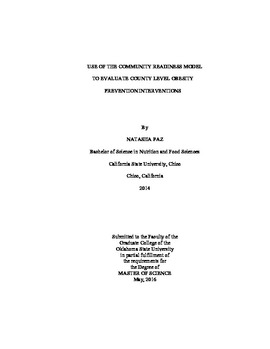| dc.contributor.advisor | Betts, Nancy | |
| dc.contributor.author | Paz, Natasha | |
| dc.date.accessioned | 2017-02-22T22:16:08Z | |
| dc.date.available | 2017-02-22T22:16:08Z | |
| dc.date.issued | 2016-05-01 | |
| dc.identifier.uri | https://hdl.handle.net/11244/49136 | |
| dc.description.abstract | The Tri-Ethnic Center�s Community Readiness Model (CRM) was used in a longitudinal study to assess the impact of a community-based obesity prevention intervention on the readiness of county residents to address healthy eating and active living issues in 21 Oklahoma counties. Readiness was assessed for counties funded by Oklahoma�s Tobacco Settlement Endowment Trust (TSET). The 9 stages of readiness range from No Awareness (1) to Community Ownership (9). Readiness is influenced by six dimensions including: 1) Existing efforts, 2) Community knowledge of the efforts, 3) Leadership, 4) Community climate, 5) Knowledge about the consequences, and 6) Resources available. The 6 key informants in each county resided there and were knowledgeable of the county but not directly involved in the efforts. The survey was composed of a series of standardized questions addressing each dimension. Pre-intervention stages were assessed in Fall 2011. County based coalitions used the findings to develop stage appropriate strategies and develop action plans focusing on the lowest scoring dimensions over a 3-year period. Post-intervention assessments were conducted in Fall 2014. Pre-intervention stages ranged from 1 (no awareness) to 3 (vague awareness), with an overall readiness of 2 (denial/resistance) across all counties. The post-intervention stages ranged from 2 (resistance/denial) to 5 (preparation), with an overall readiness of 3 (vague awareness) across all counties. Sixteen of the twenty one counties increased readiness, 3 counties had no change, and 1 county regressed. One county dropped out of the project. While all six dimensions were significant contributors to the overall readiness score (p<0.05), the strongest driver was seen in dimension A: community efforts which explained 81% of the variance in the total score. To examine the strategies used to increase readiness, the three dimensions with the lowest baseline scores were examined (Dimensions A: County efforts, D: County Climate and E: Knowledge of Consequences). Work plans including monthly briefing reports and emerging themes were used to highlight specific strategies. The approaches were aligned with the suggestions outlined in the Tri-Ethnic Center�s CRM Handbook. Healthcare professionals planning nutrition and physical activity interventions should consider using the CRA as a tool to assess the readiness of county residents to assure strategies are at the appropriate level and intensity. The model was also useful in measuring incremental progress in addressing nutritional and physical activity issues within counties. | |
| dc.format | application/pdf | |
| dc.language | en_US | |
| dc.rights | Copyright is held by the author who has granted the Oklahoma State University Library the non-exclusive right to share this material in its institutional repository. Contact Digital Library Services at lib-dls@okstate.edu or 405-744-9161 for the permission policy on the use, reproduction or distribution of this material. | |
| dc.title | Use of the Community Readiness Model to Evaluate County Level Obesity Prevention Interventions | |
| dc.contributor.committeeMember | Hildebrand, Deana | |
| dc.contributor.committeeMember | Fink, Kevin | |
| osu.filename | Paz_okstate_0664M_14481.pdf | |
| osu.accesstype | Open Access | |
| dc.description.department | Nutritional Science | |
| dc.type.genre | Thesis | |
| dc.type.material | text | |
